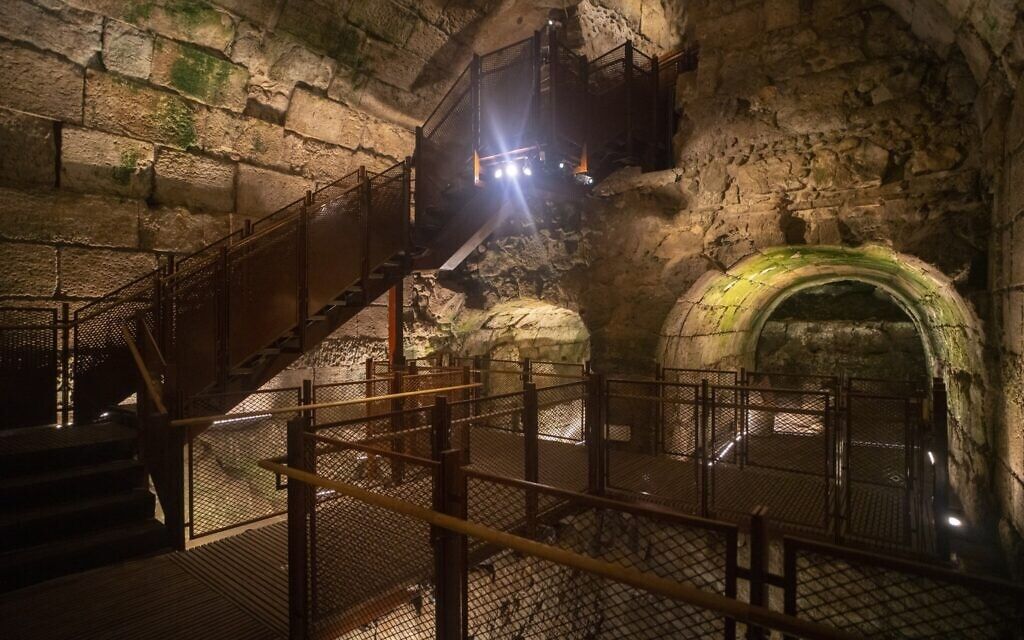Palatial, 2,000-Year-Old Public Building Revealed in Jerusalem
The grand structure, which once hosted events near the Temple Mount, will soon open to tourists
:focal(1053x692:1054x693)/https://tf-cmsv2-smithsonianmag-media.s3.amazonaws.com/filer/68/37/68375717-409e-43a1-b9ac-73d6a1ad4f4f/1-2000-.jpg)
An enormous building that hosted public functions and perhaps city government meetings in ancient Jerusalem is reopening to the public some 2,000 years after its construction.
The newly excavated structure, located next to the Israeli capital’s Western Wall, consists of two identical, elaborately decorated halls where dignitaries may have gathered while visiting the city and the Second Temple, reports Rossella Tercatin for the Jerusalem Post.
“This is, without a doubt, one of the most magnificent public buildings from the Second Temple period ever uncovered outside the Temple Mount walls in Jerusalem,” says excavation leader Shlomit Weksler-Bdolah in a statement.
British archaeologist Charles Warren first identified the building in the 19th century. Excavations and efforts to fully recover the structure moved forward in starts and stops over the next 150 or so years. Though archaeologists previously believed that the public center was built under the Hasmonean dynasty (roughly 143 to 37 B.C.), they now say that it dates to between 20 and 30 A.D.
As the Times of Israel’s Amanda Borschel-Dan reports, experts arrived at the more recent date range after pulling up some of the building’s ancient flooring and performing carbon dating on organic materials. They also found coins and pottery pieces that held clues to the timing of construction.
Weksler-Bdolah tells the Times that the team didn’t completely excavate the site because they wanted to preserve other structures in the area, which is tightly packed with historically significant ancient architecture.
“Every building is important,” she says. “We cannot take all the buildings apart.”
Between construction of the public building and the Romans’ destruction of the Second Temple in 70 A.D., the space may have hosted feasts in which guests sat on reclining wooden couches. The structure’s two large rooms were paved with enormous stone slabs, the Jewish Press reports; between the rooms stood a huge decorative fountain that used lead pipes to spout water through Corinthian capitals installed in the walls. Late in the Second Temple period, workers made changes to the building, dividing it into three chambers and installing a stepped pool that was used as a ritual bath.

Warren discovered one of the two large chambers, the eastern hall, in 1867, but archaeologists only found the second one in 2007, while conducting a tunneling project along the Western Wall, according to Ruth Schuster of Haaretz. The discovery has helped researchers determine the timing of the construction of parts of the Temple Mount compound. Archaeologists say the public building must have been constructed before the Western Wall and another part of the compound known as Wilson’s Arch. This finding supports the theory that Herod, the Roman-appointed king of Judea between 37 and 4 B.C., began a major expansion of the compound but left the project for others to complete later.
“It has [been] indicated in recent years that the expansion of the Temple Mount took longer than had been realized and hadn’t been completed in Herod’s day,” Weksler-Bdolah tells Haaretz.
The public building will be part of the Western Wall Heritage Foundation’s Western Wall Tunnels Tour, which allows tourists to travel below the modern city and visit intact ancient structures. The tour will open to visitors with a new route, including a number of recently excavated areas, ahead of Rosh Chodesh Elul (August 7-8), which marks the start of the month preceding Rosh Hashanah.
“The new route allows visitors a much better understanding of the important Western Wall Tunnel complex and will also emphasize the full extent of this magnificent building,” says Shachar Puni, an architect with the Israel Antiquities Authority’s (IAA) Conservation Department, in the statement. “By making the route accessible and open to the public, visitors are introduced to one of the most fascinating and impressive sites in the Old City of Jerusalem.”
/https://tf-cmsv2-smithsonianmag-media.s3.amazonaws.com/accounts/headshot/Livia_lg_thumbnail.png)


/https://tf-cmsv2-smithsonianmag-media.s3.amazonaws.com/accounts/headshot/Livia_lg_thumbnail.png)